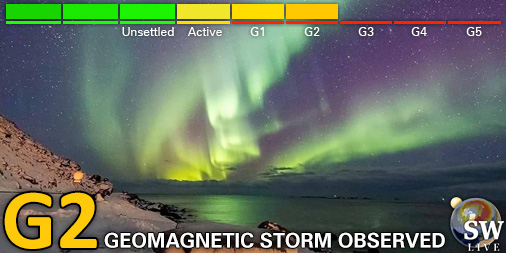Viewing archive of Friday, 11 March 2011
Solar activity report
Any mentioned solar flare in this report has a scaling factor applied by the Space Weather Prediction Center (SWPC). Because of the SWPC scaling factor, solar flares are reported as 42% smaller than for the science quality data. The scaling factor has been removed from our archived solar flare data to reflect the true physical units.
Report of Solar-Geophysical Activity 2011 Mar 11 2200 UTCPrepared by the NOAA © SWPC and processed by SpaceWeatherLive.com
Joint USAF/NOAA Report of Solar and Geophysical Activity
SDF Number 070 Issued at 2200Z on 11 Mar 2011IA. Analysis of Solar Active Regions and Activity from 10-2100Z to 11-2100Z
Solar activity was moderate. A single M1 flare was
observed from Region 1166 (N09W39) at 10/2241Z. Region 1166
decreased in area while the number of spots increased. It was
classified as an Ekc type sunspot group with Beta-Gamma-Delta
magnetic characteristics. Region 1169 (N20W09) grew in both area
and spot count, ending the period as an Eki type sunspot group with
Beta-Gamma magnetic characteristics. New Region 1172 (N11E72)
rotated onto the visible solar disk as a bi-polar sunspot group.
IB. Solar Activity Forecast
Solar activity is expected to remain
moderate for the next three days (11-13 March).
IIA. Geophysical Activity Summary 10-2100Z to 11-2100Z
The geomagnetic field ranged from quiet to active levels at
mid-latitudes with minor to major storm levels observed at high
latitudes. The ACE spacecraft indicated the Bz component of the
interplanetary magnetic field was primarily southward for most of
the period, averaging -6 nT with a maximum of -12 nT, leading to the
disturbed geomagnetic conditions. Solar wind speed averaged 400
km/s during the period.
IIB. Geophysical Activity Forecast
The geomagnetic field is
expected to be unsettled to active for the next three days (11-13
March) with a slight chance for minor to major storm conditions,
particularly at high latitudes. Effects from the 07 March CME will
slowly subside during day one (11 March), but the arrival of a
coronal hole high speed stream is expected to become geoeffective
late on day two (12 March) through day three (13 March).
III. Event Probabilities 12 Mar to 14 Mar
| Class M | 50% | 50% | 50% |
| Class X | 05% | 05% | 05% |
| Proton | 01% | 01% | 01% |
| PCAF | green | ||
IV. Penticton 10.7 cm Flux
Observed 11 Mar 123 Predicted 12 Mar-14 Mar 125/125/125 90 Day Mean 11 Mar 093
V. Geomagnetic A Indices
Observed Afr/Ap 10 Mar 014/020 Estimated Afr/Ap 11 Mar 018/035 Predicted Afr/Ap 12 Mar-14 Mar 010/018-010/010-008/008
VI. Geomagnetic Activity Probabilities 12 Mar to 14 Mar
| A. Middle Latitudes | |||
|---|---|---|---|
| Active | 15% | 20% | 15% |
| Minor storm | 10% | 15% | 10% |
| Major-severe storm | 05% | 05% | 05% |
| B. High Latitudes | |||
|---|---|---|---|
| Active | 35% | 20% | 30% |
| Minor storm | 10% | 15% | 10% |
| Major-severe storm | 01% | 10% | 10% |
All times in UTC
Current data suggests there is a slight possibility for aurora to appear at the following high latitude regions in the near future
Oulu, Rovaniemi, Sodankylä, UtsjokiKirkenes
Arkhangelsk, Murmansk, Norilsk, Vorkuta
Kiruna, Luleå
Latest news
Latest forum messages
Large Coronal Hole 25 105Photographing auroras 31AR4043 8More on an art than a science 3Space Weather Memes 689
More topicsSupport SpaceWeatherLive.com!
A lot of people come to SpaceWeatherLive to follow the Sun's activity or if there is aurora to be seen, but with more traffic comes higher server costs. Consider a donation if you enjoy SpaceWeatherLive so we can keep the website online!

Latest alerts
18:00 UTC - Geomagnetic activity
Moderate G2 geomagnetic storm (Kp6) Threshold Reached: 17:00 UTC
17:00 UTC - Geomagnetic activity
Minor G1 geomagnetic storm (Kp5) Threshold Reached: 16:28 UTC
14:15 UTC - Geomagnetic activity
Moderate G2 geomagnetic storm (Kp6) Threshold Reached: 13:58 UTC
12:18 UTC - Hemispheric Power Index
The OVATION model predicts the Hemispheric Power Index to reach 75GW at 13:21 UTC
11:54 UTC - Hemispheric Power Index
The OVATION model predicts the Hemispheric Power Index to reach 51GW at 12:57 UTC
Space weather facts
| Last X-flare | 2025/02/23 | X2.0 |
| Last M-flare | 2025/03/26 | M1.0 |
| Last geomagnetic storm | 2025/03/22 | Kp6- (G2) |
| Spotless days | |
|---|---|
| Last spotless day | 2022/06/08 |
| Monthly mean Sunspot Number | |
|---|---|
| February 2025 | 154.6 +17.6 |
| March 2025 | 135 -19.6 |
| Last 30 days | 133.7 -19.9 |





